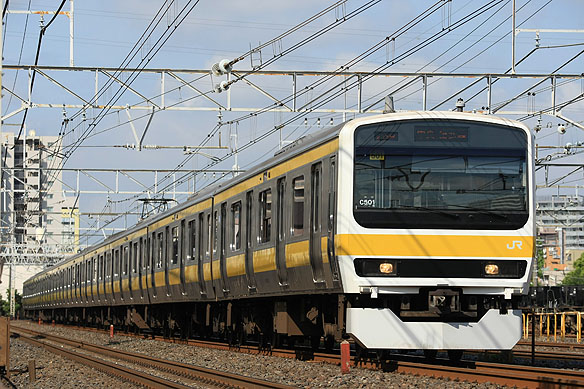Background and overview
JR East developed the pre-production type of the next generation DC electric multiple unit (EMU) commuter train classified into 209-950 series and reclassified into E231-900 series later, involving new configuration the vehicle body and equipments whereby to reduce building and maintenance cost furthermore, and delivered one 10-car set. This set needed to be undergone extensive test running throughout a period of time. However, superannuated 103 series EMU used on the commuter services of Sobu line had to be replaced immediately. Thus, JR East delivered 209-500 series employing same body construction as 209-950 series and the same other equipments and devices as 209-0 series. Nine 10-car sets consisting of 4 powered vehicles and 6 trailer vehicles were delivered to Narashino depot to be used on the Sobu line commuter services in 1998.
Car body
These sets differ noticeably from the 209-0 series in having 2950mm wide
body in order to standardize the car body for commuter and suburban trains
and in order to relieve overcrowding. As the result, the distance of each
bogie of 209-0 series EMUs is 13300mm as an optimum value of strength,
that of 209-500 series EMUs adopts 13800mm to fit the wide body within
loading gauge. In addition, although the body length of 209-0 series' end
vehicles is 420mm longer than those of intermediate vehicles, the body
length of all vehicles of 209-500 series is standardized into 19500mm,
considering that end vehicles are coupled at the mid of train set. The
construction of the body is varied depending on the manufacturer. Vehicles
built by Tokyu Car Corporation are constructed with the outside sheets
and inner beams as usual with introducing some improvements. Vehicles built
by Kawasaki Heavy Industries are employed "two-sheet construction
method" that the pressed stainless sheet and the outside sheet are
combined together and those sheets themselves keep the strength. Cab ends
are covered with a Fiber Reinforced Plastics (FRP) painted in white. Anti-fall
plates between vehicles are also introduced excepting the cab end. They
are equipped with four 1300mm wide double-leaf automatic sliding doors,
two drop windows between the doors excepting centre of the vehicles, and
three fixed windows at the end and the centre on each side of the vehicle.
Door operating equipments, TKE150, featuring electric screw drive are fitted
above the door header of the sliding doors. LED destination displays are
fitted on the side of their body. An air conditioner, AU720A, rated at
42,000kcal/h, is fitted on the centre of their roof. No ventilators are
fitted on the roof.
Bogies
The 209-500 series are equipped with DT61D bogies on the powered vehicles
and TR246L bogies on the trailers, featuring bolster-less secondary air
suspension, trailing arm link journal box supporting system, and the single
link traction device. The air suspension's effective diameter of 209-0
series is 560mm. However, that of 209-500 series is reduced to 500mm. These
bogies be prepared to adopt the yaw dampers to ensure smooth ride characteristics.
Twin Disc (TD) flexible joint employing deflecting plates made of carbon-fiber
reinforced plastic (CFRP) is applied for power transmission device. Their
brake rigging is a single tread brake for powered and both directly the
single disk and the single tread brake for trailer.
Traction unit and ancillary equipments
Class moha209-500 vehicles are equipped with 3-step Variable-frequency drive (VFD) traction system, SC41C, which controls 8 traction motors, MT73, with a power output of 95kW on vehicle basis including class moha208-500 vehicles. This traction system features modular-unit low withstand voltage Gate Turn Off (GTO) thyristor. Class moha208-500 powered intermediate vehicles are equipped with an auxiliary power unit, SC37A with a power output of 210kVA featuring GTO thyristor under their floor. Class moha209-500 powered intermediate vehicles are equipped with a compact diamond-shaped current pickup, PS28B, on their roof. Class moha208-500 powered intermediate vehicles are equipped with a motor driven screw air compressor, MH3112-C1600L under their floor. 209-500 series employ the electric commanding brake with regenerative braking.
Accommodation
Passenger accommodation consists of longitudinal bench seating featuring cantilever construction throughout, with an individual seat width of 450 mm per person. Handrails are fitted at the both end and middle of seats. The cushion of seating is made of polyester resin mold with taking recyclability.
Additional delivery
JR East additionally delivered eight 10-car sets of 2nd batch. They differ from 1st batch in having new traction motors, MT73, with a power of 95 kW, and single arm current pickup, PS33A, which are applied for 209-950 series. Last 2 sets are prepared to adopt D-ATC signaling system on the use of Keihin-Tohoku line.
Operations
They entered commuter revenue services of Sobu line in December, 1999, and all sets had been completely delivered. Then they also entered the Nambe line services in April, 1993. In November 2000, two sets were displaced with additionally delivered E231-0 series, fitted with D-ATC signaling system instead of ATS-P signaling system, and transferred to the Keihin Tohoku Line. Between 2006 and 2007, three more sets were displaced with additionally delivered E231-0 series, transferred to the Keihin-Tohoku Line in order to displace the prototype 209-900/910/920 series. Four sets used on Keihin Tohoku line were displaced with E233-1000 series and one set was transferred back to Sobu line, and the other three sets were fitted with ATS-P signaling system instead of D-ATC signaling system, and transferred to Keiyo line. Former three sets of four sets used on Keiyo line were reduced to 8 cars and relocated for use of Musashino line. Former five Sobu line sets were reduced to 4 cars, classified into -3500 subseries in order to use on Hachiko line.
209-500 series are now used on the commuter services of Keiyo and Musashino lines. |
|



